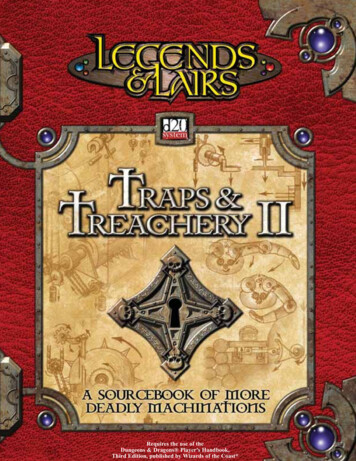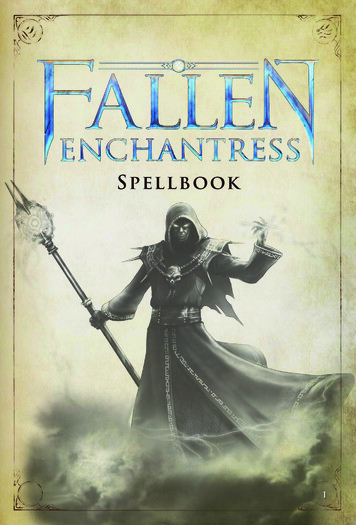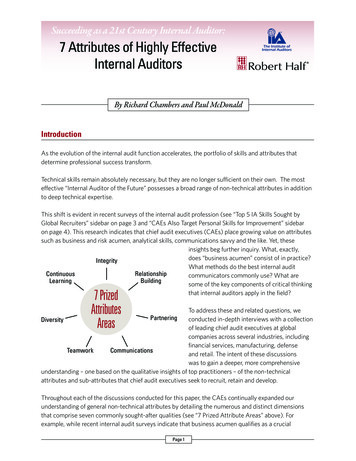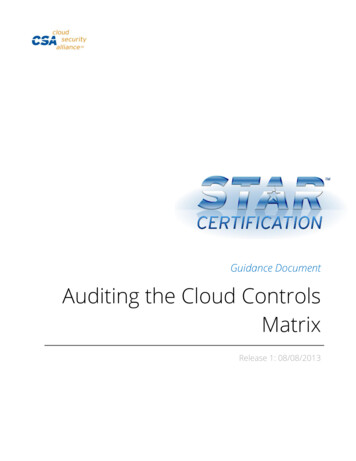
Transcription
Requires the use of theDungeons & Dragons Player's Handbook,Third Edition, published by Wizards of the Coast
Traps & Treachery IICreditsLEAD DEVELOPERWil UpchurchMANAGING DEVELOPERGreg BenageWRITINGEd Bourelle, Kurt Brown, Shaun Cashman, Mark Chance, Catten Ely, Lizard, Brian Patterson, Scott Stoecker, PaulSudlow, William Timmins, Bree ZastrowINTERIOR ILLUSTRATIONSToren Macbin Atkinson, Paul Butler, David Griffith, Kenneth Kay, Brian Schomburg, Chris Seaman, Tyler WalpoleGRAPHIC & COVER DESIGNBrian SchomburgEDITINGGreg Benage & Wil UpchurchART DIRECTIONWil UpchurchLAYOUTWil UpchurchPUBLISHERChristian T. PetersenPRINTINGBang PrintingFANTASY FLIGHT GAMES1975 W. County Rd. B2Roseville, MN 55113651.639.1905www.fantasyflightgames.com d20 System and the d20 System logo are Trademarks owned byWizards of the Coast and are used according to the terms of the d20System License version 1.0. A copy of this License can be found atwww.wizards.com.Dungeons & Dragons and Wizards of the Coast are RegisteredTrademarks of Wizards of the Coast and are used with permission.
Traps & Treachery IIContentsCHAPTER ONENew Traps: CR 1-55CHAPTER TWONew Traps: CR 6 78CHAPTER THREENew Poisons133CHAPTER FOURPuzzles & Challenges154
INTRODUCTIONIntroductionEmile Zola once said that the artist is nothingwithout the gift, but the gift is nothing withoutwork. Putting together a book of this magnitude would not be possible without the hardwork of many talented people. It is truly agroup effort, and is every bit as satisfying asanything I ve done in my life.The task at hand this time was to follow up oneof the most successful d20 releases of all time,Traps & Treachery. In some ways it was easy,the formula for success having been craftedbefore my arrival. In other ways it became achallenge to recreate that formula while puttingforth a novel product that had the same electricfeel to it. I believe that we have succeeded atthis task, and I am proud to present you withTraps & Treachery II.To all the players out there who have grownattached to their characters I m truly sorry.Wil UpchurchFantasy Flight, Inc.WelcomeFantasy Flight Games is pleased to presentTraps & Treachery II, the fifth volume in ourLegends & Lairs line of sourcebooks for thed20 System. Traps & Treachery II follows inthe footsteps of its predecessor, offering evenmore fiendish traps, mind-bending puzzles, andheroic challenges that DMs can foist upon theirplayers.Chapter 1 and Chapter 2 contain more than 100new traps to add to your game. Ranging fromthe simple traps of goblin and kobold tribes tothe most nefarious magical inventions of thefamed trapsmiths Perivax and Blackstone,these traps present a plethora of deadly optionsto throw against characters of any power level."Chapter 3 details more than 80 new poisons,both mundane and magical, that can be used byplayers and NPCs alike. Several new types ofpoisons, including monstrous and pranksterpoisons, are detailed. In addition, this bookpresents new rules detailing the rarity ofpoisons and the effects this can have on thegame.Chapter 4 presents tricks, puzzles, and challenges aplenty, providing hours of thought-provoking fun for both players and DMs. Thesesituations offer characters a chance to highlighttheir non-combat skills and players a chance toexercise their brains.The Open Game LicenseTraps & Treachery II is published under theterms of the Open Game License and the d20System Trademark License. The OGL allowsus to use the d20 System core rules and to publish gaming material derived from those rules.Material that is strictly rules related is OpenGame Content. You can use this material inyour own works, as long as you follow the conditions of the Open Game License. You cancopy the material to your website or even put itin a book that you publish and sell.Not everything in this book is Open GameContent, however. The names, mechanics, andgame statistics of races, feats, skills, equipment, spells, and magic items, and rulesderived from the d20 SRD are designated asOpen Game Content. Descriptive text, unlessotherwise noted, is closed content and cannotbe republished, copied, or distributed withoutthe consent of Fantasy Flight Games. A note atthe beginning of each section describes theopen and closed content found within.All illustrations, pictures, and diagrams in thisbook are Product Identity and the property ofFantasy Flight Games, 2002.The Open Game License is printed in its entirety at the end of this book. For further information, please visit the Open Gaming Foundationwebsite at www.opengamingfoundation.org.
New Traps:CR 1-5The dwarf moved down the passage, grumbling. Cress tried to hush the dwarf, fearing thetomb s ancient guardians would awaken tosilence his complaints permanently. The tallhuman kept his rapier in his hand, even thoughhe was certain it would be of no use should theyencounter the spirits of the dead. He couldsmell the combined stench of sweat and leatheras he fought to control his fears. Dammit, Sarina, if your god is protecting us Isure can t feel it, he said. Quiet down up there, said the priestess asshe clutched the miniature silver harp thathung from a chain around her neck. Rudan isthe god of music and revelry, not silent death.Still, I have faith he will protect us from thehorrors of this place. The three companions continued creepingdown the dark hallways, thankful their shortfriend could see through the shadows beyondtheir torchlight. Suddenly from up ahead theyheard several voices crying out in the barkinglanguage of gnolls. They want us to throw down our weapons andsurrender, said Sarina. Dammit, I can t see them! said the dwarf.CHAPTER ONE: New Traps: CR 1-5CHAPTER ONE Nor can I, said Sarina, they are beyond ourtorchlight. They say they are wielding bows! Sarina turned to her companions, trusting theiradventuring instincts far beyond her own. Quick, into those alcoves just ahead! saidCress as he tumbled toward the left side of thecorridor to avoid any oncoming arrows. In oneswift motion, the black-clad rogue sprang tohis feet and drew his crossbow.The dwarf was about to follow his lead, but justas he started to jump to his right he saw thefloor underneath the rogue rise up and dumphim into a chamber beyond. Sarina, it s a trap! said the dwarf. He thenlowered his head and charged the gnolls, cursing their decision to come into this unholyplace.IntroductionThis chapter presents full descriptions, gamestatistics, and illustrations of a variety of magical and mechanical traps. The trap names andstatistics, as well as rules and mechanicsderived from the d20 SRD, are designated asOpen Game Content. Background textand trap descriptions are designated asclosed content.#
CHAPTER ONE: New Traps: CR 1-5Several new concepts are introduced in thisbook in relation to the traps found herein.These new concepts are explained below.Outdoor TrapsIn outdoor surroundings a character must use aWilderness Lore check to place a trap; a Craft(trapmaking) check can still be used, but a 5penalty is applied to the check as most trapsrely on structures such as walls and rooms tohide their apparatuses. The Search DC requiredto find traps in the outdoors can actuallyincrease over time due to the growth of underbrush and other such obstructions that hide anyvisible mechanisms.To detect such traps, a character may use eitherSearch or Wilderness Lore. If the character has5 or more ranks in the skill he chooses not touse, he gains a 2 synergy bonus on his check.So, if a ranger with 6 ranks in Search decides touse his Wilderness Lore skill to search fortraps, he gains the synergy bonus on hisWilderness Lore check.Outdoor trap rules apply to any region that haswild vegetation or broken up landscape, andnatural paths through these areas. It does notapply to roads, areas of worked stone, or similar surroundings.Large Scale TrapsTraps are very much a staple of fantasy settings, from the poison needle of the commontreasure chest to the morbid death oubliettes ofthe Snake King. It only stands to reason that, insuch a culture, trap makers would be pressedinto service by their rulers and commanders tocreate huge or elaborate traps designed to confound or destroy large numbers of warriors at atime, especially in siege settings. Thus you willfind within these pages a number of large-scaletraps that target dozens, rather than one or fourvictims at a time.Here are some ideas on bringing such traps intothe campaign: Battle: The characters are enlisted in a battleagainst an enemy city or castle. Encountering asiege trap as a victim makes for an excitingmoment, of course. If you wish to make thetrap more central to an adventure, perhapsthe characters are assigned the task of infil-trating the castle or city and disarming the siegetraps before a major offensive commences.Espionage: The characters are hired to learnall they can about a city s defenses, includingthe existence and weaknesses of any hiddensiege traps. This may entail bribing or blackmailing a few city officials as well as a gooddeal of skulking about in borrowed uniforms.Exploration: Abandoned cities that have fallen into ruin hide many secrets some of whichmay be long forgotten siege traps still armedand dangerous. Imagine the character s surprise and dismay if in entering a lost city theyactivate a massive unhinged wall or jaw gate.Accident: A large-scale trap is accidentallytripped and the characters are either in its pathor must protect those who are. The Well ofTentacles is an excellent candidate for this sortof scenario.Terrorism: Someone, either an enemy outsideror unbalanced city official, is running around townactivating all of the siege traps, which makes leaving or entering the city a dangerous proposition.Trap EnhancementsThe following ideas are not pure traps per se;they are ways to make traps more cunning anddeadly, especially for high-level parties thatmight trivially overcome many challenges.Invisible MechanismsThe mechanics of a trap can be made invisible.This can be done by a 3rd-level mage withaccess to Craft Magic Trap and the invisibleobject spell from Traps & Treachery. The costis 500 gp over and above any other costs for thetrap. The effect is to make the trap much harder to detect, adding 5 to the DC of detectingthe trap, and even then, the DM must rule thereis some method of sensing or inferring that thetrap is there. This enhancement is used primarily on locks, but is also useful anywhere arogue visually inspects a mechanism for signsof a trap. Even if the trap is detected, DisableDevice check DCs are also increased by 5, simply because it is harder to work on what youcannot see.This adds 2 to the CR of the trap.
Suggestion GemsOnce removed from its location, the magic of asuggestion gem is broken, although it is still ahigh-quality gem (usually worth 500 gp ormore).This adds 2 to the CR of the trap.Illusion DisguiseA relatively simple figment can be placed overthe internal workings of a trap, making it seemto be a completely different trap and otherwisemaking it much harder to disable. In addition,illusions can be used to cover up joinedstonework, hide pressure plates, conceal thespace in the ceiling in which a deadfall is hidden, and so on. A mage with access to CraftMagic Trap and silent image can enhance aphysical trap with an illusion for a cost of 500gp and 20 XP. These illusions can have a rangeof effects, but the most common are:Disguise the mechanism. This adds 5 to theDisable Device DC, unless the character makesa successful Will save (DC 15).Disguise the trap. This adds 10 to the Searchcheck to notice the trap, unless the charactersucceeds at a Will save (DC 15).This adds 1 to the CR of the trap.Spring LoadedSome trap mechanisms are designed to workexceptionally fast, so fast that even a skilledrogue might find himself taken by surprise. Aspring-loaded trap is usually placed on a chestor a door lock, and the primary effect is tonegate all or part of a rogue s enhanced resistance to traps. For 2,000 gp, the trap negatesthe rogue s evasion ability. For 500 gp perThis adds 1 to the CR of the trap.False DisablingIt is a fact known to every trapmaker that,sooner or later, someone will try to disable hiscreation. Some focus solely on making bettertraps, while others try more devious tricks.This is an example of the latter. A FalseDisabling trap is designed to appear trivial todisable an obvious wire must be cut, an obvious piece of metal must be bent back.Unfortunately, this action will not disable thetrap, but will trigger it. The true DC of disabling the trap is unchanged, but it appears tobe a much simpler mechanism than it really is,thus encouraging rogues to make a try at a taskthey might not be prepared for, take fewer precautions, etc. Any failure will trigger the trap.A Spot check (DC 25) is allowed just beforethe disable attempt to reveal the subterfuge.CHAPTER ONE: New Traps: CR 1-5A suggestion gem is created via the CraftMagic Trap feat, requiring a 5th-level casterwith the ability to cast suggestion, 2,500 gp,and 100 XP. The gem is then integrated into anarea near a trap, usually as part of a wall decoration or a mosaic on the ceiling. The suggestion made is invariably some action that willtrigger the trap, causing invaders or thieves topull random levers, place their hands intoalcoves, look through peepholes, hastily grabthe idol from the pedestal, and otherwise actwithout caution.point of negated bonus, the trap negates onepoint of the rogue s uncanny dodge save bonusagainst traps. (In other words, for 500 gp, theuncanny dodge bonus is reduced by one, 1,000gp buys a two point reduction, and so on.) Thebonus can never be reduced below 0.This adds 1 to the CR of the trap.False TrapsFalse traps are slightly less lethal than normaltraps but far more frustrating. The main purpose of such traps is to confuse or slow a partyof invaders while keeping the cost of buildingtraps considerably lower than normal. For 100gp, a skilled craftsman can create the appearance of hairline seams in a wall, construct anelaborate but meaningless mechanism in alock, or set stones in a pathway so that theyappear to be trigger plates. It requires a successful Spot check (DC 20) to identify a falsetrap for what it is. Any Disable Device checksautomatically fail, but with each attempt thecharacter gains a new Spot check to note thedeception.One particularly fun false trap, called FalseHollow, requires Craft Magic Trap, ghostsound, 500 gp, and 20 XP to build. Characterswho tap a wall or otherwise look for hollowspaces hear the faint echo that indicates a passage lurks just beyond a seemingly solidwall. Tremendous amounts of time couldbe spent looking for a secret door, or just%
CHAPTER ONE: New Traps: CR 1-5trying to break down the wall. (If more thanfive cubic feet of stone is removed from thewall in which a False Hollow has been placed,the spell is broken.) This false trap s primaryuse is to keep a party occupied, and noisy, thusattracting guards and keeping the party in oneplace while the guards approach.False Traps should be considered CR 1 to 3,and the DM should consider an ad hoc XPaward to any character that figures out the rusewithout resorting to skill checks.Lockpick DestructionThere are several locks, usually door and chestlocks, which are designed with complex mechanisms whose purpose is not to damage thethief, but his tools. The nasty bit is that in orderto disarm these traps you need to put your toolsinto them, making even the slightest errorextremely annoying.Two common variants are the acid trap and thelocking trap.The acid trap usually has interior componentsmade of ceramic and glass, or else the metalcomponents are alchemically treated to resistacid. On any failed Open Lock or DisableDevice check, the acid pours over the picks,destroying them unless the rogue succeeds at aReflex save (DC 25) to yank them back. Therogue s bonus to Reflex saves due to uncannydodge applies to this check.The locking trap uses a set of gears and springsto clamp down on any picks or probes that haveentered the lock. The picks are then held in thelock. Removing them without breaking them isdifficult, requiring a successful Disable Devicecheck (DC 25). Failure means that the tools arebroken and the lock has been jammed or damaged, causing additional Open Lock checks tosuffer a 4 penalty.Locks with these mechanisms are consideredCR 1.New TrapsThe traps found within these pages are organized according to Challenge Rating, fromlowest to highest.&All Wrapped UpTrap Type: Binding TrapConstruction Type: MagicActivation Type: InstantTrigger: Local; magicMechanism: MagicEffect: HindranceAttack Bonus: No attack roll necessaryDamage: NoneSave: Reflex save (DC 14) avoidsSearch DC: 26Disable Device DC: 26Challenge Rating: 1Construction Time/Cost: 1 day; 500 gp; 20XPThis is an amusing trap that is usually combined with an alarm. One big advantage of thetrap is that it is not very dangerous. This is useful for inhabited buildings, where a servant orvisitor can get lost.When a character steps on the trap s symbol,animate rope is cast. This causes any rope thatis carried by the character to move and entangle the bearer. If the target is not carrying anyrope, the trap triggers but has no effect. Thetrap could be used on an item, perhaps with acommand word override. Sometimes a rope isplaced nearby so that the trap cannot fail. It isoften hidden within a chandelier or curtain soas to avoid tipping off observant trespassers.Subtle signs of struggle around the trap providea clear sign for observant rogues. The wearmarks are unusual, compared to normal traffic.The symbol is repeated elsewhere, but isengraved a bit more precisely here.Cloak and DaggerTrap Type: Pit TrapConstruction Type: Simple mechanicalActivation Type: InstantTrigger: Local; switchMechanism: GravityEffect: EnsnarementAttack Bonus: No attack roll necessaryDamage: 2d6Save: Reflex save (DC 17) negatesSearch DC: 20Disable Device DC: 20Challenge Rating: 1Construction Time/Cost: 1 week; 1,000 gp
However, this is meant only as an obvious ruse.A character notices the rope and cage with asuccessful Spot check (DC 12). What makesthe trap truly fiendish are the two 20 ft. deep, 5ft. by 5 ft. pits on either side of the tree that arehidden by a cloth and covered with dirt. Thesepits make up the second part of the trap.CHAPTER ONE: New Traps: CR 1-5The Cloak and Dagger trap has two parts: oneto fool victims and the other to catch them. It isprimarily used by primitive humanoids such askobolds and goblins to capture creatures thatmight be too powerful for them in a straightfight. The first part of the trap involves a wooden cage suspended in the branches of a tree bya single rope. About four feet from the trunk isa dagger pinning an old, ratty cloak, usually ofa bright color, to the tree. The cloak semi-hidesthe rope, which is also pinned to the tree by thedagger. Removing the dagger releases the ropeand drops the cage.A clever individual will probably wish toremove the dagger and follow the old adagethat says, If it isn t nailed down, pick it up. By merely sidestepping the tree and grabbingthe dagger from the side, a character does nothave to worry about the cage, but falls in a pitinstead.A victim who falls in a pit takes 2d6 points offalling damage and must succeed at a Climbcheck (DC 20) to get out. A victim who actually fails to notice the cage before it falls maymake a Reflex save (DC 15) to jump out of theway (possibly landing in a pit.) An individualtrapped under the cage needs to make aStrength check (DC 18) to break free. In orderto make the trap even deadlier, the creator mayplace snakes, scorpions, or other poisonouscreatures in the pits.The dagger is a normal, everyday blade and thecloak is smelly, full of holes, and completelyworthless.'
CHAPTER ONE: New Traps: CR 1-5CrossfireTrap Type: Crossbow TrapConstruction Type: Simple mechanicalActivation Type: InstantTrigger: Local; pressure plateMechanism: SpringEffect: InjuryAttack Bonus: 10 rangedDamage: 1d8 per boltSave: NoneSearch DC: 20Disable Device DC: 20Challenge Rating: 1Construction Time/Cost: 1 week; 1,000 gpCrossfire is a simple mechanical trap designedto harm or kill intruders. The room that holdsthe trap is a small temple of sorts with an altarat the far end of the room. Raised, brightly colored tiles cover the floor, and the walls and pillars bear paintings that depict the exploits of agod and his followers.The trap consists of crossbows held in hollowpillars to either side of the door. The pillars arevery close to the wall nearest to the door, sointruders must pass between them. The crossbows fire through small holes hidden in thedesigns on the pillars.The trigger for the trap is the tile sectionbetween the pillars. As all the tiles are raised,the trigger is difficult to see. Stepping onto anyof the trapped tiles sets off the trap. Two bolts,one from each of the adjacent pillars, shoot outwards toward the trespasser. If only one personstepped on the tile, he is the target of both. Iftwo people triggered the trap simultaneously,one bolt is aimed at each. If more than twostepped forward, determine the targets randomly. Each crossbow holds only one bolt, so afterone triggering the trap is rendered useless untilreloaded.The simplest way to disable the trap is to plugthe holes from which the bolts shoot. Anotherpossibility is to jam the trigger mechanism withpitons. Each pillar has a hidden door (SearchDC 17) on the rear side where the trap can bereloaded. 2d4 bolts can typically be found ineach pillar, and 30% of the time the bolts willbe blessed.
Hangman s Last LaughHangman s Last Laugh is a simple trap typically used by primitive tribes of humanoids, suchas goblins and kobolds. The trap uses a decoyto deliver a debilitating poison to curious interlopers. It is sometimes used as a hunting technique, although it is much more commonlyseen protecting important tribal areas.CHAPTER ONE: New Traps: CR 1-5Trap Type: Poison TrapConstruction Type: Simple mechanicalActivation Type: InstantTrigger: Local; tripwireMechanism: TripwireEffect: InjuryAttack Bonus: No attack roll necessaryDamage: PoisonSave: Fortitude save (DC 18) resistsSearch DC: 20Disable Device DC: 20Challenge Rating: 1Construction Time/Cost: 1 week; 1,000 gpA hanged humanoid body is suspended severalfeet above the ground, the rope slung over atree branch or outcropping of rock. The body isdressed normally, though the poor condition ofthe clothing suggests the body has been in itscurrent position for quite a while. Preservativesare used to prevent rotting, and foul smellingherbs keep scavengers away from the body. Asign hung around the neck reads Die filthyhuman, die! or something appropriate to thecreature hanging there. The words are verysmall, the sign being designed to bring the victims as close to the poison as possible.Tripwires are hidden (Spot check DC 15) in thegrass surrounding the body. Tripping over thewires causes a small, spring-loaded blade to cutthe rope holding up the body, dropping it to theground. When the body hits the ground it splitsopen and releases a noxious poison. Movingthe corpse causes the body to fall apart as well.The body is held together by crude stitches hidden beneath the corpse s clothing, and the poison gas is sealed in fragile sacks made fromspecially prepared animal stomachs.When the body falls apart, the gas is released,affecting all creatures in a 10-ft. radius. Burnedbarla root is the most common poison used inHangman s Last Laugh (Fortitude save DC 18,initial damage 1d2 Con, secondary damage1d4 1 Con).
CHAPTER ONE: New Traps: CR 1-5It is easy to avoid the Hangman s Last Laughby stepping over the tripwire and not touchingthe body. Otherwise, following the tripwire toits source reveals the blade used to cut the rope(Disable Device check DC 20).Ink MineTrap Type: Aquatic Ink Cloud TrapConstruction Type: Simple mechanicalActivation Type: InstantTrigger: Local; tripwireMechanism: Spring, pressureEffect: Hindrance, identificationAttack Bonus: No attack roll necessaryDamage: NoneSave: Reflex save (DC 22) avoidsSearch DC: 20 (see text)Disable Device DC: 20Challenge Rating: 1Construction Time/Cost: 1 week; 1,000 gpAquatic races use ink mines around the perimeters of their Underdeep lairs to deter trespassersand provide a visual warning to their presence.When triggered, the ink mine launches a specially treated bladder that leaves a trail ofopaque squid ink.The tripwire for an ink mine can be placedalong a sea or cavern floor or it can be suspended between two objects such as reefembankments. A suspended tripwire canbecome covered in drifting sediment and mustbe cleaned weekly or suffer a 2 to its SearchDC for each week that it goes without maintenance. A creature that comes into contact withthe tripwire must make a Reflex save (DC 22)in order to stop itself from applying enoughpressure to the wire to trigger the mine.Creatures with at least 5 ranks in Swim gain a 2 circumstance bonus to this Reflex save.When the ink mine is triggered, a piece of coralor other sharp material punctures a hole in thepressurized ink bladder. The release of the inkacts as a propellant, pushing the bladder2d4x10 ft. in a predetermined direction. Thecloud, which spreads in a 20-ft. radius alongthe path of the bladder, provides total concealment and creatures within the cloud suffer theeffects of total darkness. In calm water, thecloud dissipates in 3d6 rounds.Although the tripwire for this trap is generallytranslucent, it is almost always the first thing a
LongpitTrap Type: Pit TrapConstruction Type: Simple mechanicalActivation Type: InstantTrigger: Local; pressure plateMechanism: GravityEffect: InjuryAttack Bonus: No attack roll necessaryDamage: 2d6Save: Reflex save (DC 21) to avoidSearch DC: 20Disable Device DC: 20Challenge Rating: 1Construction Time/Cost: 1 week; 1,000 gpThe basic pit trap has many problems, and trapdesigners have found many solutions to themover the years. One of the major problems isthat most pits will trap one, or perhaps two,intruders at a go, while extensive surveys bytrapmaster Acand Deyryn have indicated theaverage number of individuals invading a complex is four. This makes it trivial for those whohave been trapped to escape, if they survive thefall.The Longpit is a simple, inexpensive, solutionto this problem. The pit is usually built in a narrow corridor, and fills an area at least 40 ft.long by 5 ft. wide. The trigger is at the farthestpoint from the likely entrance to the corridor,so that the entire group will be standing overthe mouth of the pit when it opens. The personwho triggers the trap (usually the leader of theparty) can make a Reflex save to avoid it; therest simply fall in.The pit is a minimum of 20 ft. deep, largeenough to impose an obstacle when everyone isinside it. The walls are usually polished quitesmooth, so climbing out is extremely difficult.(It is also possible to have a single wall that iseasier to climb; this is an excellent place to usea Falling Wall or Burning Wall trap).This trap is used only in areas where intrudersare likely to be weak or not well equipped; itdoes not pose a serious threat to more advancedadversaries. Detecting it is fairly simple; thevery large open area beneath the trap door mayecho oddly, and the floor itself vibrates slightlyas it is walked upon. Disabling it is likewisesimple. Once the trigger plate has been located,even a marginally skilled rogue can easily jamit. However, the low expense and general utility against minor threats makes this trap popularas a filter mechanism; it eliminates weakintruders early, preventing the expense and difficulty of rearming traps that were designed todeal with much more serious threats.Mantle of DreadTrap Type: Fear TrapConstruction Type: MagicActivation Type: InstantTrigger: Local; magicMechanism: MagicEffect: HindranceAttack Bonus: No attack roll necessaryDamage: NoneSave: Will save (DC 11) negatesSearch DC: 26Disable Device DC: 26Challenge Rating: 1Construction Time/Cost: 1 day; 500 gp; 20XPCHAPTER ONE: New Traps: CR 1-5successful Search check (DC 20) reveals.Disabling the ink mine is a simple matter of disconnecting the tripwire or removing the springfrom the puncturing device. The delicate bladder holds about a gallon of concentrated ink andrequires a Reflex save (DC 15) each round thatit is handled to keep it from breaking.This trap is traditionally placed before the statue of a god. Anyone approaching is subject tothe fear effects, and begins quaking in terror.Some temples to war gods place these traps totest the nerve of aspirants. Darker temples usethe trap as atmosphere. It can also be placed soas to distract intruders, causing them to run intoother, more dangerous traps. If placed near theentrance to a place of solitude or solemnity, itcan screen out casual annoyances.The trigger is based on body heat passing overit. Undead, plants, and other beings with nosuch heat do not activate the trap. It does notreact to torches or other forms of heat, as itspecifically keys on the body heat of normalcreatures. A heat source like a torch will confuse the trigger, however, and block it.Once activated, the trap casts cause fear on thetarget. The focus of the dread is typically thestatue or icon of a god. The fear could also beof an entrance, or simply a feeling of terroremanating from a specific direction. Theeffect lasts 1d4 rounds.!
CHAPTER ONE: New Traps: CR 1-5The outlines of the trap are not hard to spot.Wavy black lines etched into the ground areclear to the trained eye. Chiseling one of thewavy lines deactivates the trap and its magicaltrigger.Meal SpearsTrap Type: Spear TrapConstruction Type: Complex mechanicalActivation Type: InstantTrigger: Local; pressure plateMechanism: Pressure, gearEffect: InjuryAttack Bonus: 6 rangedDamage: 1d8Save: NoneSearch DC: 21Disable Device DC: 21Challenge Rating: 1Construction
Dungeons & Dragons Player's Handbook, Third Edition, published by Wizards of the Coast .











